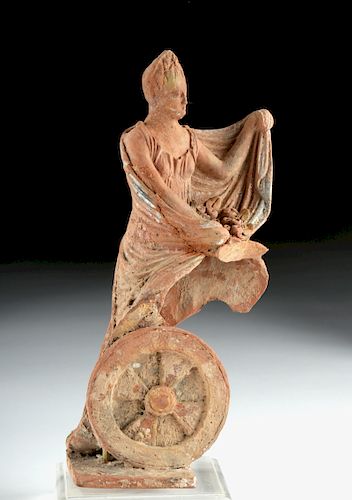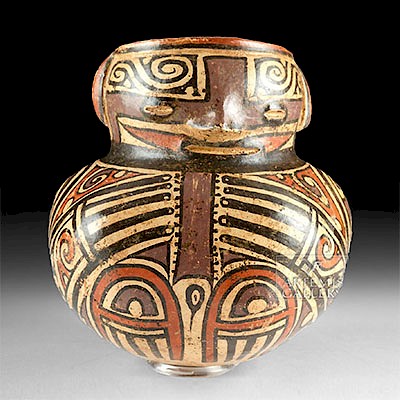Greek Hellenistic Terracotta Fortuna on Chariot
Lot 18f
About Seller
Artemis Fine Arts
686 S Taylor Ave, Ste 106
Louisville, CO 80027
United States
Selling antiquities, ancient and ethnographic art online since 1993, Artemis Gallery specializes in Classical Antiquities (Egyptian, Greek, Roman, Near Eastern), Asian, Pre-Columbian, African / Tribal / Oceanographic art. Our extensive inventory includes pottery, stone, metal, wood, glass and textil...Read more
Estimate:
$4,000 - $6,000
Absentee vs Live bid
Two ways to bid:
- Leave a max absentee bid and the platform will bid on your behalf up to your maximum bid during the live auction.
- Bid live during the auction and your bids will be submitted real-time to the auctioneer.
Bid Increments
| Price | Bid Increment |
|---|---|
| $0 | $25 |
| $300 | $50 |
| $1,000 | $100 |
| $2,000 | $250 |
| $5,000 | $500 |
| $10,000 | $1,000 |
| $20,000 | $2,500 |
| $50,000 | $5,000 |
| $100,000 | $10,000 |
| $200,000 | $20,000 |
About Auction
By Artemis Fine Arts
Nov 8, 2018
Set Reminder
2018-11-08 10:00:00
2018-11-08 10:00:00
America/New_York
Bidsquare
Bidsquare : Ancient / Ethnographic From Around The World
https://www.bidsquare.com/auctions/artemis-gallery/ancient-ethnographic-from-around-the-world-3598
Ancient art from Egypt, Greece, Italy and the Near East, as well as Asian, Pre-Columbian, Native American, African / Tribal / Oceanic, Spanish Colonial, Russian Icons, Fine art, much more! Artemis Fine Arts info@artemisgallery.com
Ancient art from Egypt, Greece, Italy and the Near East, as well as Asian, Pre-Columbian, Native American, African / Tribal / Oceanic, Spanish Colonial, Russian Icons, Fine art, much more! Artemis Fine Arts info@artemisgallery.com
- Lot Description
Greece, Hellenistic period, ca. late 4th to 2nd century CE. A gorgeous mold-made figure of the goddess Fortuna standing on a chariot. She raises her himation with both hands, inside which at her waist she cradles a multitude of fruit, creating a picture of abundance. The statue is beautifully done, with an incredible level of detail on the goddess's body, clothing, and face. Below her is the large, spoked wheel of a chariot, all that remains of what was once the full vehicle. The entire statue rests upon a thin, flat platform. Size: 4.75" W x 8.5" H (12.1 cm x 21.6 cm); 9.45" H (24 cm) on included custom stand.
We know from Pompeii and other classical domestic sites that votive statues like this were made to placed inside of altars, known as lararia, in private homes. In the Greek world, they were located in the courts and peristyles of homes, in contrast to the Roman world, where they were often in gardens and kitchens. Researchers believe that this is because cult worship in the Greek world was more public than in the Roman world, so visitors to a Greek home could take part in religious activities alongside the family. Fortuna was one of the most common deities worshipped in private homes, and she is often depicted, as she is here, with her cornucopia, in order to bring prosperity and luck. You can imagine standing before this beautiful figure, asking the goddess to bring wealth to your family and friends.
Provenance: private East Coast, USA collection; ex-Frances Artuner collection, Belgium, acquired in the 1960s
All items legal to buy/sell under U.S. Statute covering cultural patrimony Code 2600, CHAPTER 14, and are guaranteed to be as described or your money back.
A Certificate of Authenticity will accompany all winning bids.
We ship worldwide and handle all shipping in-house for your convenience.
#139659Piece is a fragment as shown. Fragment has not been repaired. Nice remaining detail. Deposits on surface, especially in lower profile areas.Condition
- Shipping Info
-
All shipping is handled in-house for your convenience. Your invoice from Artemis Gallery will include shipping calculation instructions. If in doubt, please inquire BEFORE bidding for estimated shipping costs for individual items.
-
- Buyer's Premium



 EUR
EUR CAD
CAD AUD
AUD GBP
GBP MXN
MXN HKD
HKD CNY
CNY MYR
MYR SEK
SEK SGD
SGD CHF
CHF THB
THB















